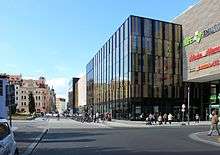Brühl (Leipzig)

The ![]() Brühl is a street in Leipzig, Germany, just within the former city wall.
Brühl is a street in Leipzig, Germany, just within the former city wall.
History


On the corner of the Brühl and Katharinestrasse stands the Romanus house, built for the mayor of Leipzig between 1701 and 1704, and one of the finest baroque buildings remaining in the town.[1]
In the late 18th century and early 19th century, the Brühl was part of the Jewish quarter of the city.
The Brühl retained Jewish connections into the 20th century. The street was the centre of the World fur trade. Chaim Eitingon,[2] the Russian-born 'king of the fur trade', opened a branch there in 1893, and in the 1920s the street represented one-third of the world trade in furs.[3]
Only 4.2% of Leipzigers as a whole worked in the fur industry, but 8.7% of Jewish Leipzigers did. The Brühl was an emblem of Jewish economic activity in Leipzig, and of the city as a whole[4]
In 1938, under the Nazi government, 'the entire Brühl district changed hands, as fur firms — the pinnacle of Jewish commerce in the city, along with the department stores — were stolen from their owners'.[5]
Today the street contains a few 19th-century and early 20th-century buildings, most of the remaining buildings being from the third quarter of the 20th century. A notable modern building is the town's Museum der bildenden Künste (Museum of the visual arts).
Wagner's birthplace

It was in the Brühl, in 1813, that the composer Richard Wagner was born[6] at no. 3, the 'House of the Red and White Lions'. Ironically, Wagner's disciple Theodor Uhlig, in an 1850 essay which Wagner was later to build on for his own essay Das Judenthum in der Musik, condemned the music of Meyerbeer by linking it to the Jewish quarters of Leipzig and Dresden: 'If that is dramatic song, then Gluck, Mozart, Cherubini and Spontini carried out their studies at the Neumarkt in Dresden or the Brühl in Leipzig.'[7] Wagner's birthplace was demolished in 1886, three years after his death, and the site is now occupied by a disused (as of August 2008) department store, built in 1968 to a design of the architect Harry Müller. It is hoped to replace this building over the next few years with a new construction that could incorporate parts of the foundations of the Wagner house and will contain a memorial to the composer.
A parallel street to the Brühl is now named Richard-Wagner-Straße.
References
- Robert Allen Willingham II, Jews in Leipzig:Nationality and Community in the 20th Century, PhD dissertation, University of Texas, consulted online, 7 August 2008
Notes
- ↑ Official Leipzig city website Archived July 31, 2008, at the Wayback Machine.
- ↑ See article in German Wikipedia
- ↑ Official Leipzig tourist service web-site Archived July 17, 2011, at the Wayback Machine.
- ↑ Willingham (2005), p. 25
- ↑ Willingham (2005), p.123
- ↑ "My Life — Volume 1 by Richard Wagner" (Ebook). Project Gutenberg.
- ↑ Neue Zeitschrift für Musik, 23 April 1850, p. 270
External links
| Wikimedia Commons has media related to Brühl (Leipzig). |
Coordinates: 51°20′34″N 12°22′42″E / 51.34278°N 12.37833°E